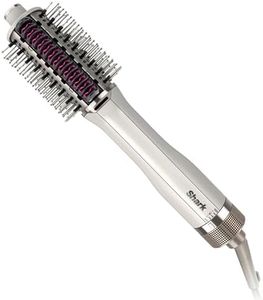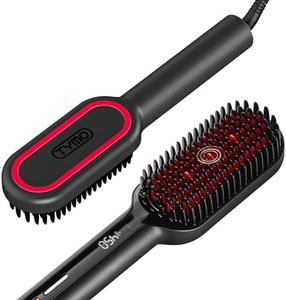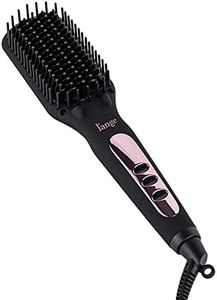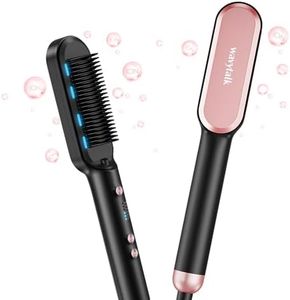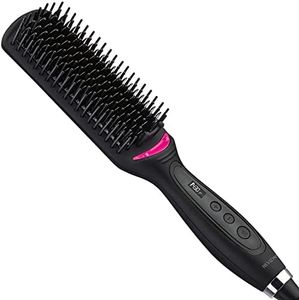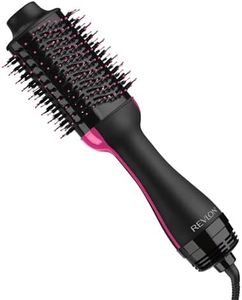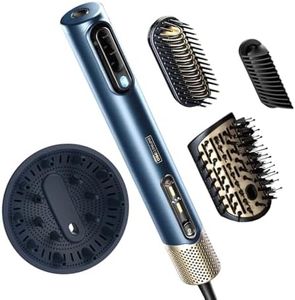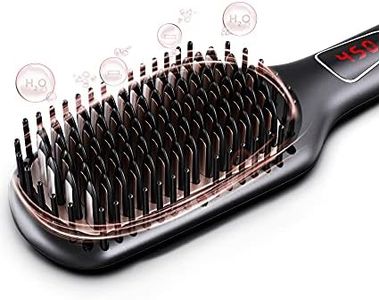We Use CookiesWe use cookies to enhance the security, performance,
functionality and for analytical and promotional activities. By continuing to browse this site you
are agreeing to our privacy policy
10 Best Straightening Brushes
From leading brands and best sellers available on the web.Recommended lists
Buying Guide for the Best Straightening Brushes
Choosing the right straightening brush can make a big difference in your daily hair routine. The goal is to find a brush that suits your hair type, desired style, and comfort level. When shopping, focus on the features that impact performance, safety, and ease of use. Understanding the key specifications will help you narrow down your options and select a brush that delivers smooth, straight hair without causing damage.Plate MaterialThe plate material refers to what the heated part of the brush is made from, and it plays a big role in how the brush interacts with your hair. Common materials include ceramic, tourmaline, and titanium. Ceramic plates heat evenly and are gentle on most hair types, making them a popular choice for everyday use. Tourmaline plates help reduce frizz and add shine, which is great for people with frizzy or dull hair. Titanium plates heat up quickly and can reach higher temperatures, which is useful for thick or coarse hair but may be too harsh for fine or damaged hair. To pick the right one, consider your hair’s texture and how much heat it can handle—gentler materials for fine or damaged hair, and stronger materials for thick or stubborn hair.
Temperature RangeThe temperature range tells you how hot the brush can get, and this is important because different hair types need different levels of heat to straighten effectively. Lower temperatures (around 250-300°F) are best for fine, thin, or damaged hair, as they minimize the risk of heat damage. Medium temperatures (300-375°F) work well for normal or medium-textured hair. Higher temperatures (375-450°F) are suitable for thick, coarse, or curly hair that needs more heat to straighten. Look for a brush with adjustable temperature settings so you can match the heat to your hair’s needs and avoid unnecessary damage.
Bristle Type and DesignThe bristles are the part of the brush that actually touch your hair, and their design affects both comfort and effectiveness. Some brushes have plastic bristles, while others use ceramic or a mix. Softer, flexible bristles are gentler on the scalp and help detangle hair, making them good for sensitive scalps or fine hair. Stiffer bristles can handle thicker or more tangled hair but may feel rougher. The spacing and length of the bristles also matter—closely spaced, longer bristles work better for thick or long hair, while shorter, widely spaced bristles are easier for short or fine hair. Choose a bristle type that matches your hair’s thickness and your comfort preferences.
Heat-Up TimeHeat-up time is how long the brush takes to reach the desired temperature after you turn it on. Faster heat-up times (under a minute) are convenient if you’re often in a hurry, while longer times may not matter if you have a more relaxed routine. If you value speed and efficiency, look for a brush that heats up quickly, but remember that even fast-heating brushes should still distribute heat evenly to avoid hot spots.
Safety FeaturesSafety features are built-in protections that help prevent accidents or damage. Common features include automatic shut-off, which turns the brush off after a certain period of inactivity, and heat-resistant tips or handles to prevent burns. These features are especially important if you tend to forget to unplug devices or if you have children or pets around. If safety is a concern for you, prioritize brushes with these extra protections.
Size and WeightThe size and weight of the straightening brush affect how easy it is to handle and store. Larger brushes can cover more hair at once, making them faster for long or thick hair, but they may be harder to maneuver for short hair or detailed styling. Lighter brushes are easier to hold for longer periods, which is helpful if you have a lot of hair or limited hand strength. Consider your hair length and how comfortable you want the brush to feel during use when choosing the right size and weight.
Cord Length and SwivelCord length and whether the cord swivels can make a big difference in how easy the brush is to use. A longer cord gives you more freedom to move around, which is helpful if your outlet is far from your mirror. A swivel cord prevents tangling and makes it easier to maneuver the brush at different angles. If you want a hassle-free experience, look for a brush with a long, swivel cord.

